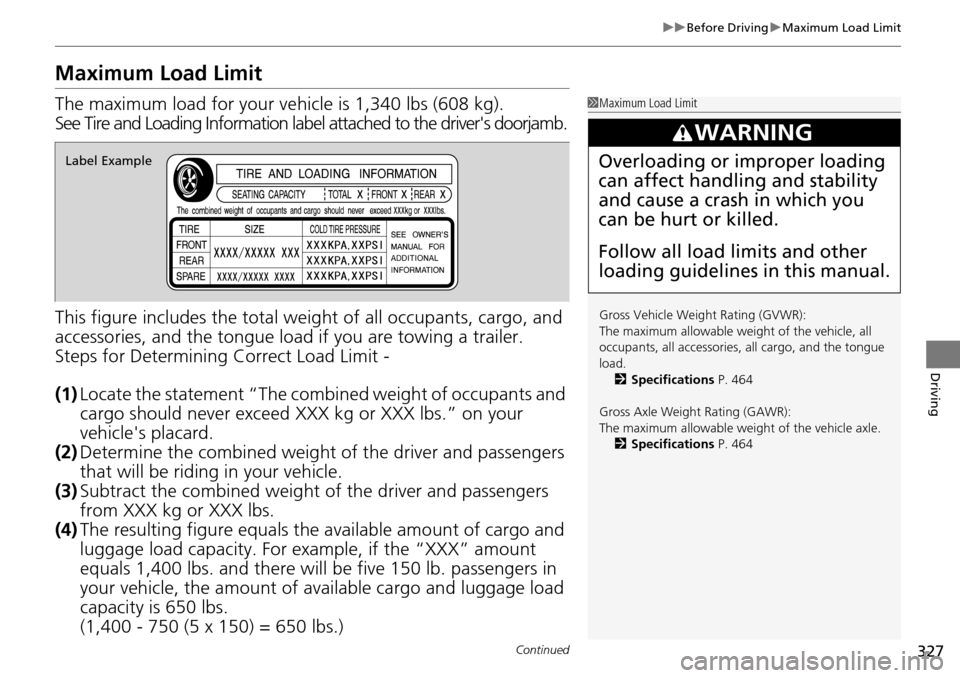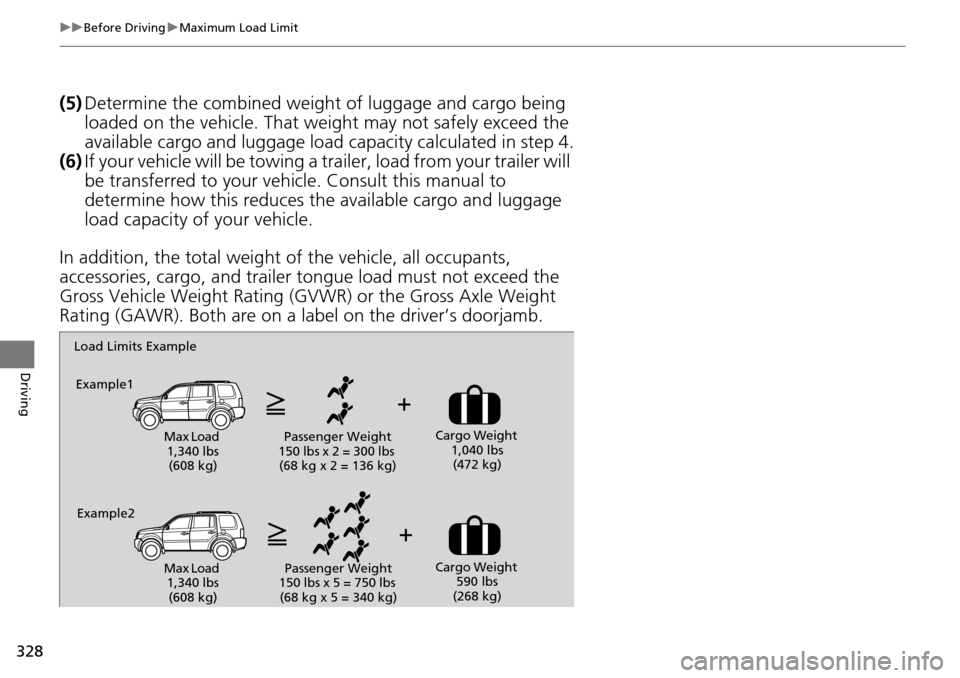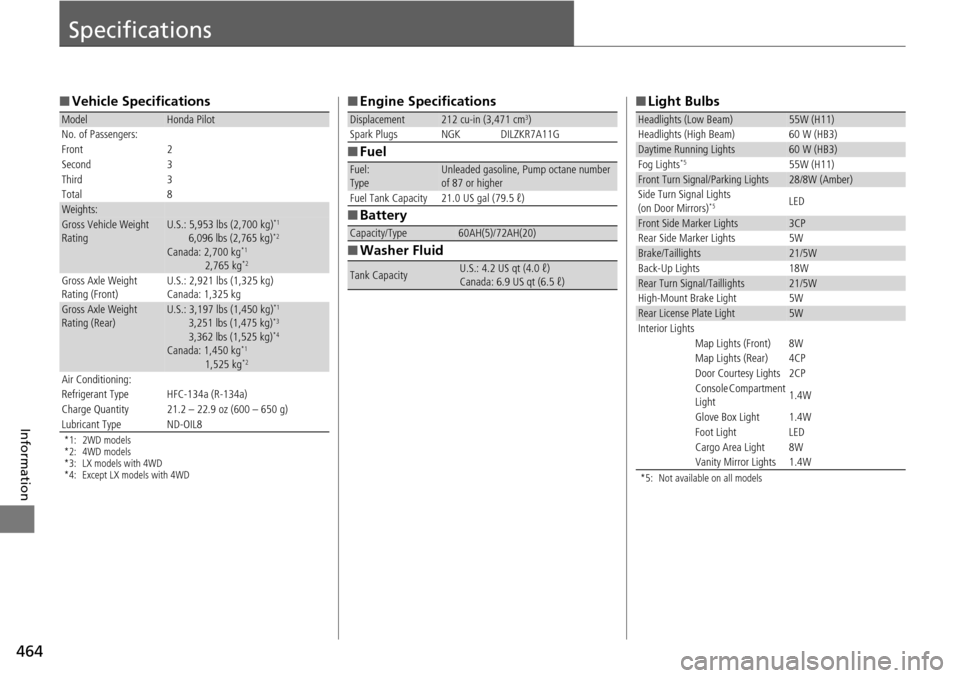2014 HONDA PILOT capac
[x] Cancel search: capacPage 16 of 488

15
Quick Reference Guide
VSA® OFF Button (P 353)
● The v
ehicle stability assist (VSA ®) system
helps stabilize the vehicle during
cornering, and helps maintain traction
while accelerating on loose or slippery
road surfaces.
● VSA ® co
mes on automatically every time
you start the engine.
● To
turn VSA ® on or off, press and hold
the button until you hear a beep.
Cruise Control (P 348)
● Cru
ise control allows you to maintain a
set speed without keeping your foot on
the accelerator pedal.
● To use crui
se control, press the CRUISE
button, then press DECEL/SET button
once you have achieved the desired speed
(above 25 mph or 40 km/h).
Tire Pressure Monitoring
System (TPMS)
(P355)
● TPMS monit
ors tire pressure.
● TPMS is turn ed on automatically every
time you start the engine.
Refueling (P 371)
aPull the fuel fill door
release handle.
bTurn the fuel fill cap
slowly to remove the
cap.
cPlace the cap in the
holder on the fuel fill
door.
dAfter refueling, screw
the cap back on until it
clicks at least once.
Fuel recommendation: Unleaded gasoline with a pump octane number 87 or
hi
gher required
Fuel tank capacity: 21 US gal (79.5 L)
Page 328 of 488

327
uu Before Driving u Maximum Load Limit
Continued
Driving
Maximum Load Limit
The maximum load for your ve hicle is 1,340 lbs (608 kg).
See Tire and Loading Information label attached to the driver's doorjamb.
This figure includes the total weig ht o
f all occupants, cargo, and
accessories, and the tongue load if you are towing a trailer.
Steps for Determining Correct Load Limit
-
(1) Locate
the statement “The comb ined weight of occupants and
cargo should never exceed XXX kg or XXX lbs.” on your
vehicle's placard.
(2) Deter
mine the combined weight of the driver and passengers
that will be riding in your vehicle.
(3) S
ubtract the combined weight of the driver and passengers
from XXX kg or XXX lbs.
(4) T
he resulting figure equals the available amount of cargo and
luggage load capacity. For example, if the “XXX” amount
equals 1,400 lbs. and there will be five 150 lb. passengers in
your vehicle, the am ount of available cargo and luggage load
capacity is 650 lbs.
(1,400 - 750 (5 x 150) = 650 lbs.)
1 Maximum Load Limit
Gross Vehicle Weight Rating (GVWR):
The maximum allowable weight of the vehicle, all
occupants, all a ccessories, all cargo, and the tongue
load. 2 Specifications P. 464
Gross Axle Weight Rating (GAWR):
The maximum allowable weight of the vehicle axle. 2 Specifications P. 464
3 WARNING
Overloading or improper loading
can affect handling and stability
and cause a crash in which you
can be hurt or killed.
Follow all load limits and other
loading guidelines in this manual.Label Example
Page 329 of 488

328
uu Before Driving u Maximum Load Limit
Driving
(5) Determine the combined weight of luggage and cargo being
loaded on the vehicle. That we ight may not safely exceed the
available cargo and luggage load capacity calculated in step 4.
(6) If your vehicle will be towing a tra iler, load from your trailer will
be transferred to your vehicl e. Consult this manual to
determine how this reduces the available cargo and luggage
load capacity of your vehicle.
In addition, the total weight of
the vehicle, all occupants,
accessories, cargo, and trailer tongue load must not exceed the
Gross Vehicle Weight Rating (GVW R) or the Gross Axle Weight
Rating (GAWR). Both are on a label on the driver’s doorjamb.
Load Limits Example
Example1
Max Load 1,340 lbs (608 kg) Passenger Weight
150 lbs x 2 = 300 lbs (68 kg x 2 = 136 kg) Cargo Weight
1,040 lbs (472 kg)
Example2
Max Load 1,340 lbs (608 kg) Passenger Weight
150 lbs x 5 = 750 lbs (68 kg x 5 = 340 kg) Cargo Weight
590 lbs
(268 kg)
Page 373 of 488

uu Refueling u How to Refuel
372
Driving
■Gasoline containing ethanol
Some gasoline today is blended with oxygenates such as ethanol. Your vehicle is
desi
gned to operate on oxygenated gasoline containing up to 15% ethanol by
volume. Do not use gasoline containing methanol. If you notice any undesirable
operating symptoms, try another service st ation or switch to another brand of
gasoline.
■Fuel tank capacity: 21.0 US gal (79.5 liters)
How to Refuel
1. Stop your vehicle with the service station
pump on the left side of the vehicle in the
rear.
2. Turn
off the engine.
3.Pull on the
fuel fill door release handle
under the lower left corner of the
dashboard.
u Th
e fuel fill door opens.
1How to Refuel
3 WARNING
Gasoline is highly flammable and explosive.
You can be burned or seriously injured
when handling fuel.
• Stop the engine, and keep heat, sparks,
and flame away.
• Handle fuel only outdoors.
• Wipe up spills immediately.
Pull
Page 374 of 488

373
uu Refueling u How to Refuel
Driving
4. Remove the fuel fill cap slowly. If you hear a
release of air, wait until this stops, then turn
the knob slowly to open the fuel fill cap.
5. Place the fuel fill cap in the holder.
6. In
sert the fuel filler nozzle fully.
u When the ta
nk is full, the filler nozzle will
click off automatically. This leaves space
in the fuel tank in case the fuel expands
with a change in the temperature.
7. After fill
ing, replace the fuel fill cap,
tightening it until you hear it click at least
once.
u Sh
ut the fuel fill door by hand.
1How to Refuel
The filler nozzle automatically stops to leave space in
the fuel tank so that fuel does not overflow as a result
of changes in air temperature.
If the fuel filler nozzle keeps turning off when the
tank is not full, there ma y be a problem with the
pump's fuel vapor recovery system. Try filling at
another pump. If this does not fix the problem,
consult a dealer.
Do not continue to add fuel after the nozzle has
automatically stopped. Addi tional fuel can exceed
the full tank capacity.
Cap
Cap
Holder
Page 397 of 488

uu Maintenance Under the Hood u Changing the Engine Oil and Oil Filter
396
Maintenance
4. Remove the oil filter and dispose of the
remaining oil.
5.Check that the filter ga sket is not stuck to
the engine contact surface.
u If it
is stuck, you must detach it.
6. Wipe away
dirt and dust adhering to the
contact surface of the engine block, and
install a new oil filter.
u Appl
y a light coat of new engine oil to
the filter gasket.
7. Pu
t a new washer on the drain bolt, then
reinstall the drain bolt.
u Tighte
ning torque:
29 lbf∙ft (39 N∙m, 4.0 kgf∙m)
8. P
our the recommended engine oil into the
engine.
u Engi
ne oil change capacity (including
filter):
4.5 US qt (4.3 L)
9. Reins
tall the engine oil fill cap securely and
start the engine.
10. Run the engin
e for a few minutes, and
then check that there is no leak from the
drain bolt or oil filter.
11. S
top the engine, wait for three minutes,
and then check the oil level on the
dipstick.
u If neces
sary, add more engine oil.
1Changing the Engine Oil and Oil Filter
You will need a special wrench to replace the oil
filter. You can buy this wrench from a dealer.
When installing the new oil filter, follow the
instructions supplied with the oil filter.
Reinstall the engine oil fill cap. Start the engine. The
low oil pressure indicator should go off within five
seconds. If it does not, turn off the engine, and check
your work.
Oil Filter
Page 465 of 488

464
Information
Specifications
■Vehicle Specifications
*1: 2WD models
*2: 4WD models
*3: LX models with 4WD
*4: Except LX models with 4WD
ModelHonda Pilot
No. of Passengers:
Front 2
Second 3
Third 3
Total
8Weights:Gross Vehicle Weight
Rating U.S.: 5,953 lbs (2,700 kg)*1
6,096 lbs (2,765 kg)*2
Canada: 2,700 kg*1
2,765 kg*2
Gross Axle Weight
Rating (Front)U.S.: 2,921 lbs (1,325 kg)Canada: 1,325 kgGross Axle Weight
Rating (Rear)U.S.: 3,197 lbs (1,450 kg)*1
3,251 lbs (1,475 kg)*3
3,362 lbs (1,525 kg)*4
Canada: 1,450 kg*1
1,525 kg*2
Air Conditioning:Refrigerant Type HFC-134a (R-134a)Charge Quantity21.2 – 22.9 oz (600 – 650 g)Lubricant TypeND-OIL8
■ Engine Specifications
■ Fuel
■ Ba
ttery
■Wa
sher Fluid
Displacement212 cu-in (3,471 cm3)
Spark Plugs NGKDILZKR7A11G
Fuel:TypeUnleaded gasoline, Pump octane number
of 87 or higher
Fuel Tank Capacity 21.0 US gal (79.5 ℓ)
Capacity/Type60AH(5)/72AH(20)
Tank CapacityU.S.: 4.2 US qt (4.0 ℓ)
Canada: 6.9 US qt (6.5 ℓ)
■Light Bulbs
*5: Not available on all models
Headlights (Low Beam)55W (H11)
Headlights (High Beam)60 W (HB3)Daytime Running Lights60 W (HB3)
Fog Lights*555W (H11)Front Turn Signal/Parking Lights28/8W (Amber)
Side Turn Signal Lights
(on Door Mirrors)
*5 LED
Front Side Marker Lights3CP
Rear Side Marker Lights5WBrake/Taillights21/5W
Back-Up Lights18WRear Turn Signal/Taillights21/5W
High-Mount Brake Light5WRear License Plate Light5W
Interior Lights Map Lights (Front) 8W
Map Lights (Rear) 4CP
Door Courtesy Lights 2CP
Console Compartment
Light 1.4W
Glove Box Light 1.4W
Foot Light LED
Cargo Area Light 8W
Vanity Mirror Lights 1.4W
Page 466 of 488

465
uu Specifications u
Information
■Brake Fluid
■Automatic Transmission Fluid
*1: 2WD models
*2: 4WD models
■Rear Differential Fluid *
■Transfer Assembly Fluid *
SpecifiedHonda Heavy Duty Brake Fluid DOT 3
SpecifiedHonda ATF DW-1
(automatic transmission fluid)
Capacity Change 3.2 US qt (3.1 ℓ)
*1
3.6 US qt (3.4 ℓ)*2
SpecifiedHonda VTM-4 Differential Fluid
Capacity Change2.79 US qt (2.64 ℓ)
SpecifiedHYPOID GEAR OIL API GL4 or GL5
SAE75W-85 (SAE90 CAN BE USED)
Capacity Change0.45 US qt (0.43 ℓ)
■Engine Oil
■ En
gine Coolant
Recommended·Genuine Honda Motor Oil 0W-20
·API Premium-grade 0W-20 detergent oil
Capacity Change
4.2 US qt (4.0 ℓ)
Change
includi
ng
filter 4.5 US qt (4.3 ℓ)
SpecifiedHonda Long-Life Antifreeze/Coolant Type2
Ratio50/50 with distilled water
Capacity1.98 US gal (7.5 ℓ)
(change including the remaining
0.198 US gal (0.75 ℓ) in the reserve tank)
■ Tire
*3: U.S. LX
*4: Except U.S. LX
Regular
SizeP235/65R/17 103T*3
P235/60R/18 102T*4
Pressure
psi (kPa [kgf/cm2])
Front31 (210 [2.1])*3
35 (240 [2.4])*4
Rear33 (230 [2.3])*3
35 (240 [2.4])*4
Compact
Spare Size
T165/80D17 104M
Pressure
psi (kPa [kgf/cm
2])60 (420 [4.2])
Wheel SizeRegular17 x 7.5J*3
18 x 7.5J*4
Compact Spare17 x 4T
* Not available on all models